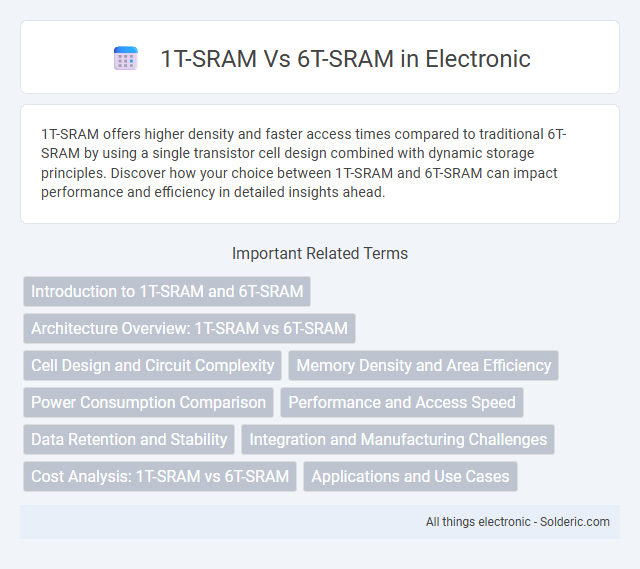1T-SRAM offers higher density and faster access times compared to traditional 6T-SRAM by using a single transistor cell design combined with dynamic storage principles. Discover how your choice between 1T-SRAM and 6T-SRAM can impact performance and efficiency in detailed insights ahead.
Comparison Table
| Feature | 1T-SRAM | 6T-SRAM |
|---|---|---|
| Cell Structure | 1 Transistor + 1 Capacitor | 6 Transistors |
| Density | Higher, more compact | Lower, larger cell area |
| Speed | Moderate access speed | Faster access speed |
| Power Consumption | Lower leakage power | Higher leakage power |
| Volatility | Volatile memory | Volatile memory |
| Data Retention | Requires refresh like DRAM | Retains data as long as powered |
| Manufacturing Complexity | More complex due to capacitor integration | Less complex, established process |
| Use Cases | Embedded SRAM, cache in SoCs | High-speed caches, processor registers |
Introduction to 1T-SRAM and 6T-SRAM
1T-SRAM and 6T-SRAM are two types of static random-access memory technologies used in integrated circuits, with 6T-SRAM utilizing six transistors per bit for stable storage and 1T-SRAM leveraging a single transistor combined with dynamic techniques to achieve higher density. 6T-SRAM offers faster access times and better data retention without refresh cycles, making it ideal for cache memory in processors. Your choice between 1T-SRAM and 6T-SRAM depends on factors like density needs, power consumption, and access speed requirements in your application.
Architecture Overview: 1T-SRAM vs 6T-SRAM
1T-SRAM architecture integrates a single transistor with dynamic memory cells and embedded control circuitry to emulate static RAM behavior, optimizing density and cost. In contrast, 6T-SRAM uses six transistors per cell to achieve true static memory with faster access times and higher stability but at the expense of larger area and power consumption. Your choice between 1T-SRAM and 6T-SRAM depends on the trade-off between cell size, speed, power efficiency, and application requirements.
Cell Design and Circuit Complexity
1T-SRAM uses a single transistor combined with a capacitor to create a simpler cell design compared to the traditional 6T-SRAM, which employs six transistors per cell for data storage. The reduced transistor count in 1T-SRAM lowers circuit complexity and area, enabling higher density memory integration. Your choice between these SRAM types impacts power consumption and speed due to the differing trade-offs in cell design architecture.
Memory Density and Area Efficiency
1T-SRAM offers higher memory density and better area efficiency compared to traditional 6T-SRAM by utilizing a single-transistor configuration combined with dynamic RAM cells, allowing more bits to be packed into a smaller silicon area. This compact design reduces the overall chip size and enables increased memory capacity without sacrificing performance or reliability. Your choice of 1T-SRAM can lead to more efficient use of die space, making it ideal for applications demanding high-density memory integration.
Power Consumption Comparison
1T-SRAM offers significantly lower power consumption compared to 6T-SRAM due to its single-transistor design combined with dynamic memory techniques, which reduce leakage currents. The 6T-SRAM cell, built with six transistors, consumes more static power primarily because of continuous current flow to maintain data stability. Consequently, 1T-SRAM is highly preferred in low-power applications where energy efficiency is critical.
Performance and Access Speed
1T-SRAM offers higher density and faster access speeds compared to traditional 6T-SRAM, making it ideal for applications requiring large cache memories with reduced latency. The single-transistor design in 1T-SRAM enables quicker read and write operations, enhancing overall performance in embedded systems and mobile devices. In contrast, 6T-SRAM's six-transistor cell design provides robust stability but at the cost of larger cell size and slightly slower access times.
Data Retention and Stability
1T-SRAM offers improved data retention by integrating DRAM cells with SRAM-like control, providing a stable intermediate solution with refresh cycles that extend retention time compared to volatile 6T-SRAM cells, which store data in bistable flip-flops but are more power-hungry. The 6T-SRAM provides high stability for data due to its four transistor-latch design but is sensitive to noise and process variations, impacting low-voltage operation reliability. Your choice between 1T-SRAM and 6T-SRAM depends on balancing retention requirements and stability under varying power and environmental conditions.
Integration and Manufacturing Challenges
1T-SRAM offers higher integration density compared to 6T-SRAM due to its use of DRAM-like storage cells combined with SRAM architecture, enabling greater memory capacity on the same silicon area. The manufacturing process of 1T-SRAM involves complex capacitor fabrication steps, increasing production complexity and cost, whereas 6T-SRAM benefits from a simpler CMOS process with well-established techniques. Integration of 1T-SRAM with logic circuits poses challenges related to process compatibility and yield optimization, making 6T-SRAM more straightforward for high-volume production despite lower density.
Cost Analysis: 1T-SRAM vs 6T-SRAM
1T-SRAM offers cost advantages over 6T-SRAM due to smaller cell size, enabling higher density and reducing silicon area consumption in memory design. Manufacturing complexity of 1T-SRAM is balanced by fewer transistors per cell, lowering production expenses compared to the six-transistor configuration in 6T-SRAM. Your choice between 1T-SRAM and 6T-SRAM impacts overall system cost, balancing performance needs with fabrication and integration efficiencies.
Applications and Use Cases
1T-SRAM offers high density and low cost, making it ideal for embedded memory in consumer electronics like smartphones and gaming consoles, where space and power efficiency are critical. 6T-SRAM provides superior speed and stability, which suits high-performance applications such as CPU caches and networking equipment requiring fast, reliable data access. Your choice depends on balancing density versus performance needs in specific use cases.
1T-SRAM vs 6T-SRAM Infographic

 solderic.com
solderic.com